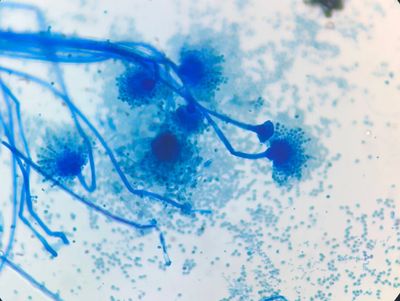Now Offering Airborne Mycotoxin Testing
MOLD and MYCOTOXINS

What Are Mycotoxins?
Certain Molds are known for producing Mycotoxins, chemical byproducts utilized as a defense mechanism against other molds and fungi competing for resources in the same environment. These mycotoxins can easily become dispersed in the air and adhere to surfaces within your home causing various potential adverse health effects. It is essential to be mindful of mycotoxins when dealing with mold in any indoor environment when health issues are a concern.
Mycotoxins VS Mold Spores
Mold spores and mycotoxins are two different things. Mold spores, being biological in nature, can cause symptoms resembling allergies like hay fever. Mycotoxins are chemical poison that can result in various health issues from short term ailments to severe conditions, like cancer.
What Is The Benefit of Combining Mycotoxin Testing along with Spore Trap Testing?
It's crucial to use both spore trap testing and mycotoxin testing when evaluating the health of your indoor environment. While spore trap testing detects the genus of mold present, mycotoxin testing determines toxic chemicals produced by active or previously active molds that can heavily endanger your well being. By incorporating these two testing methods you can obtain a more comprehensive evaluation of your home or buildings quality and safety.
Should I Do A Mycotoxin Analysis?
In most cases of indoor mold growth our industry standard mold spore air samples are adaquet, however in certain situations when you are dealing with indivuals who are genetically presdisposed to be sensitive to mycotoxins, or there has been elevated mycotoxin levels in your blood or urine test, it may be necessary to test for airborne mycotoxins to ensure maximum safety in the indoor air environment.
What type of Mycotoxin Testing is Available
We offer both Air and Surface Mycotoxin Testing
Until recently the only way to test for Mycotoxin's was thorugh a dust sample using either your HVAC air filter (Bulk Sample) or a swab to gather dust from various surfaces around your home. While this is still a viable and great diagnostic tool, we are excited to now offer a revolutinary new test that allows us to sample mycotoxins in the air, reaching a new level of precision, accuracy, and standardizations thanks to a groundbreaking patented extraction method used in combination with ELISA for this new test.

The Science behind the Mycotoxin Sampling Process
MYCOTOXIN AIR TESTING
MYCOTOXIN SURFACE/Dust TESTING
MYCOTOXIN SURFACE/Dust TESTING

ACTIVE SAMPLING
Prior to air sampling, the air in the room is conditioned to simulate normal activity by stirring it up prior to testing. This helps to provide consistent results and replicate what you would actively inhale.
THE BREATHING ZONE
Samples for testing are collected at a height of 5-6ft from the ground, which is commonly referred to as the “breathing zone”. This method ensures that the samples accurately represent the mycotoxins that could potentially be inhaled.
PATENTED PROCESS
The developer of the mycotoxin air test, uses a patented extraction process to prepare samples for industry-standard ELISA tests. Enzyme-Linked Immunosorbent Assay (ELISA), is a highly recognized form of analysis commonly used for the identification and quantification of mycotoxins.
REPORTS
Mycotoxin testing relies on thorough research conducted by labs, which has established average background levels for indoor airborne mycotoxins. Your test results are then compared against these established levels and reported in parts per billion (ppb) per cubic meter for better interpretation.
MYCOTOXIN SURFACE/Dust TESTING
MYCOTOXIN SURFACE/Dust TESTING
MYCOTOXIN SURFACE/Dust TESTING

COLLECTION METHOD
To detect and measure the most common mycotoxins found on indoor surfaces, we simply collect a sample from surfaces such as from the examples below to be sent for analysis. These samples can be in the form of a swab or bulk.
HVAC SYSTEMS
Did you know that HVAC systems might be spreading mycotoxins in your home or building? These toxins can easily travel through the system and contaminate the air you breathe. One way to check if your HVAC system needs cleaning or if it’s actively contributing to the spread of mycotoxins is by getting a swab of your return air duct or a cutting a bulk sample from the air filter.
WALLS
Another option is to obtain a wall sample from where visible mold is/was present to check for mycotoxins.
FURNITURE
After experiencing mold or water damage, it’s crucial to ensure that your furniture is free from any residual mycotoxins and safe to use. A surface sample from furniture can determine whether a cleaning solution is needed to maintain the furniture’s quality and safety to your family and pets.
Frequently Asked Questions About Mycotoxins
Please reach us at info@themoldguyz.com if you cannot find an answer to your question.
All our Mycotoxin panels test for the three most common mycotoxins: Ochratoxin A, Aflatoxin Group, and Trichothecene Group. Then depending on which modality of testing is suggested, certain panels will also test for Gliotoxin, Zearalenone, Vomitoxin, & Fumonisin.
Due to their chemical structure and resistance to breakdown, mycotoxins can persist even after mold removal. Testing is necessary to identify the mycotoxins present, then the speciality protocols to facilate the removal of mycotoxins can be address and prevent ongoing health complications.
Mold Allergy is an immune response to mold spores, which results in symtoms such as hives, itchy eyes, runny nose, and in worse case sceniro's anaphylaxis; However Mycotoxin Tocicity is poisoning caused by exposure to high levels of mycotoxins produced by molds. Its the inability to break down mycotoxins.
While some mold is associated with a musty odor or wet smell, Mycotoxins produced by mold does not have a scent.
No, as mold grows, certain molds may produce mycotoxins under the right conditions. No one can tell whether a mold is producing mycotoxins just by looking at it.
